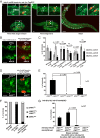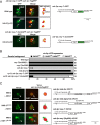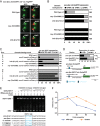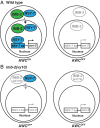A universal transportin protein drives stochastic choice of olfactory neurons via specific nuclear import of a sox-2-activating factor
- PMID: 31767767
- PMCID: PMC6911211
- DOI: 10.1073/pnas.1908168116
A universal transportin protein drives stochastic choice of olfactory neurons via specific nuclear import of a sox-2-activating factor
Abstract
Stochastic neuronal cell fate choice involving notch-independent mechanisms is a poorly understood biological process. The Caenorhabditis elegans AWC olfactory neuron pair asymmetrically differentiates into the default AWCOFF and induced AWCON subtypes in a stochastic manner. Stochastic choice of the AWCON subtype is established using gap junctions and SLO BK potassium channels to repress a calcium-activated protein kinase pathway. However, it is unknown how the potassium channel-repressed calcium signaling is translated into the induction of the AWCON subtype. Here, we identify a detailed working mechanism of how the homeodomain-like transcription factor NSY-7, previously described as a repressor in the maintenance of AWC asymmetry, couples SLO BK potassium channels to transactivation of sox-2 expression for the induction of the AWCON subtype through the identification of a unique imb-2 (transportin 1) allele. imb-2 loss-of-function mutants are not viable; however, we identify a viable imb-2 allele from an unbiased forward genetic screen that reveals a specific role of imb-2 in AWC olfactory neuron asymmetry. IMB-2 specifically drives nuclear import of NSY-7 within AWC neurons to transactivate the expression of the high mobility group (HMG)-box transcription factor SOX-2 for the specification of the AWCON subtype. This study provides mechanistic insight into how NSY-7 couples SLO BK potassium channels to transactivation of sox-2 expression for the induction of the AWCON subtype. Our findings also provide structure-function insight into a conserved amino acid residue of transportins in brain development and suggest its dysfunction may lead to human neurological disorders.
Keywords: NSY-7; asymmetry; sox-2; stochastic choice; transportin 1.
Conflict of interest statement
The authors declare no competing interest.
Figures






Similar articles
-
SLO BK Potassium Channels Couple Gap Junctions to Inhibition of Calcium Signaling in Olfactory Neuron Diversification.PLoS Genet. 2016 Jan 15;12(1):e1005654. doi: 10.1371/journal.pgen.1005654. eCollection 2016 Jan. PLoS Genet. 2016. PMID: 26771544 Free PMC article.
-
Intercellular calcium signaling in a gap junction-coupled cell network establishes asymmetric neuronal fates in C. elegans.Development. 2012 Nov;139(22):4191-201. doi: 10.1242/dev.083428. Development. 2012. PMID: 23093425 Free PMC article.
-
The microRNA mir-71 inhibits calcium signaling by targeting the TIR-1/Sarm1 adaptor protein to control stochastic L/R neuronal asymmetry in C. elegans.PLoS Genet. 2012;8(8):e1002864. doi: 10.1371/journal.pgen.1002864. Epub 2012 Aug 2. PLoS Genet. 2012. PMID: 22876200 Free PMC article.
-
Stochastic left-right neuronal asymmetry in Caenorhabditis elegans.Philos Trans R Soc Lond B Biol Sci. 2016 Dec 19;371(1710):20150407. doi: 10.1098/rstb.2015.0407. Philos Trans R Soc Lond B Biol Sci. 2016. PMID: 27821536 Free PMC article. Review.
-
Asymmetric neural development in the Caenorhabditis elegans olfactory system.Genesis. 2014 Jun;52(6):544-54. doi: 10.1002/dvg.22744. Epub 2014 Feb 7. Genesis. 2014. PMID: 24478264 Free PMC article. Review.
Cited by
-
Neurogenesis in Caenorhabditis elegans.Genetics. 2024 Oct 7;228(2):iyae116. doi: 10.1093/genetics/iyae116. Genetics. 2024. PMID: 39167071 Free PMC article. Review.
-
Sox2 and βIII-Tubulin as Biomarkers of Drug Resistance in Poorly Differentiated Sinonasal Carcinomas.J Pers Med. 2023 Oct 18;13(10):1504. doi: 10.3390/jpm13101504. J Pers Med. 2023. PMID: 37888115 Free PMC article.
-
Synergistic roles of homeodomain proteins UNC-62 homothorax and MLS-2 HMX/NKX in the specification of olfactory neurons in Caenorhabditis elegans.Genetics. 2021 Oct 2;219(2):iyab133. doi: 10.1093/genetics/iyab133. Genetics. 2021. PMID: 34849889 Free PMC article.
-
Whole genome sequencing facilitates intragenic variant interpretation following modifier screening in C. elegans.BMC Genomics. 2021 Nov 13;22(1):820. doi: 10.1186/s12864-021-08142-8. BMC Genomics. 2021. PMID: 34773966 Free PMC article.
-
Karyopherin-βs play a key role as a phase separation regulator.J Biochem. 2021 Sep 22;170(1):15-23. doi: 10.1093/jb/mvab072. J Biochem. 2021. PMID: 34223614 Free PMC article. Review.
References
-
- Reiner S. L., Adams W. C., Lymphocyte fate specification as a deterministic but highly plastic process. Nat. Rev. Immunol. 14, 699–704 (2014). - PubMed
Publication types
MeSH terms
Substances
Grants and funding
LinkOut - more resources
Full Text Sources
Molecular Biology Databases
Research Materials
Miscellaneous


